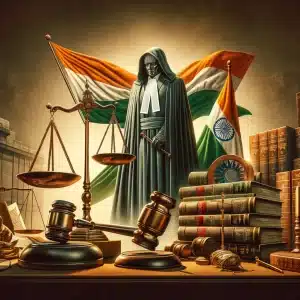Authored By: Akash Awana, A Final Year Student (2021) of Faculty of Law, University of Delhi
INTRODUCTION
The Oxford Dictionary defines ‘contempt’ as the state of being despised or dishonored; disgrace. Any conduct which tends to bring the authority and administration of law into disrespect or disregard or to interfere with or prejudice parties or their witness during litigation is considered to be contempt of court, as per Oswald Dictionary. The verb used for ‘to commit contempt’ is ‘contemn’ (as to contemn a court order) and a person guilty of this is a ‘contemnor’.
The ‘Contempt’ has not been defined anywhere in Indian Legislation but it is vaguely mentioned under the definition clause under section-2(a) of the Contempt of Court 1971 as Civil and Criminal Contempt. There are different cases relevant to the evolution of this field of jurisprudence which clarifies the meaning and its application for the general public. If we see as per the rule of literal or grammatical interpretation of the legislation, The court can take the literal meaning of the term ‘contempt’ from the dictionary.
This act defines and limits the powers of certain courts in punishing contempt of courts and regulating their procedure in relation thereto. For upholding the majesty and dignity of law courts and their image in the minds of the public. To keep the administration of justice pure and undefiled.
HISTORICAL BACKGROUND
The oldest records of penalties were contained in the Regulating Act 1773, which stated that the newly formed Mayor’s Court of Calcutta would have the same powers as a court bench of the English King have to punish persons for contempt. Courts established in India under the British colony followed the common law principle that all courts of record had the inherent power to punish for contempt.
The Act of 1926 on Contempt of Courts was enacted to resolve a conflict between the High Courts in India on whether they had the power to penalize offenses of contempt committed against other high courts, subordinate courts that fell under their jurisdiction. The Act of 1926 allowed the High Courts to penalize contempt against subordinate courts as well as against their judgments and proceedings.
The enactment of The Constitution of India in 1950 specifically established the Supreme Court of India as well as High Courts in the states of India as courts of record with the power to punish such persons who acted in contempt of the Court. The Contempt of court can also be a ground on which the right to freedom of speech in India can be restricted.
The Contempt of Courts Act 1926 was later replaced by a new statute with the same name in 1952, which expanded the power to punish for contempt from High Courts to other courts as well.
In 1961, a committee headed by then Additional Solicitor General for the Government of India, H.N. Sanyal, was appointed to examine and evaluate the application of the contempt laws in India. The Sanyal Committee recommended that the contempt proceedings should be initiated not by the courts themselves but on the recommendation of a law officer of the government. The recommendations of the committee were incorporated in the Contempt of Courts Act of 1971, enacted by the Parliament of India, which is the current legislation governing contempt of courts in India.
EVOLUTION THROUGH JUDICIAL INTERVENTION:
In 1969, a challenge to the constitutional validity of the Contempt of Courts Act 1971 was dismissed by the Supreme Court of India, where the apex court found the law to be substantively valid.
The powers of the courts for criminal contempt have been repeatedly criticized by former judges and lawyers as having a chilling effect on freedom of speech, on being too wide and uncertain in its definition, and lending itself to misuse to shield the judiciary from criticism. Senior advocate Sanjay Hegde argued that the offense of ‘scandalizing the court’ is incapable of precise definition, and it is derived from English law, where it has since been abolished.
In 1978, The contempt case was initiated by Chief Justice M.H. Beg against two newspaper editors from the Times of India and the Indian Express for the publication of articles that contained criticisms of the Supreme Court’s decision in ADM Jabalpur v. Shiv Kant Shukla, in which the Supreme Court refused to protect the right to habeas corpus during the Emergency. The case was ultimately dropped as Chief Justice M.H. Beg did not get support from the other two judges on the bench in his opinion that contempt had been committed.
In 1981, The Kerala High Court tried V. K. Krishna Iyer, a former Supreme Court judge, for criminal contempt after receiving a complaint from a person who heard the speech by a judge criticizing the functioning of the judiciary in India but the court found him not guilty of the charges.
In 1997, Shiv Sena leader Bal Thackeray was convicted of contempt of court by the Bombay High Court, after he accused a judge of corruption in a public speech. The Supreme Court set aside his conviction on appeal, in 2004 on the ground that the case of contempt was not maintainable as it was registered by a private person without the permission of the Advocate General and was not a Suo Motu case.
In 2010, MV Jayarajan, a leader of the Communist Party of India (Marxist), was convicted of contempt of court after he criticized a Kerala High Court decision in which the court banned meetings in a certain public place. He was sentenced to six months’ imprisonment, which was reduced to four months on appeal to the Supreme Court.
In 2001, the Delhi High Court issued a notice to editor and journalist Madhu Trehan and four other people, in connection with an article published in the (now defunct) magazine, ‘Wah India’. The article in question had asked senior advocates in Delhi to anonymously rate Delhi High Court judges better on various grounds, including their perceived honesty. The Delhi High Court found them guilty of contempt but accepted an apology and did not penalize the offense.
In 2002, Arundhati Roy, a famous writer, was arrested and charged with contempt of court by the Supreme Court of India, after she wrote an article criticizing one of the judgments of the court concerning the Narmada Dam, and participated in a protest regarding this outside the Court. Right after her arrest, Arundhati Roy made a further statement questioning the Supreme Court’s initiation of contempt proceedings against her and turned down the Court’s offer to allow her to escape punishment with an apology. She was imprisoned for one day and fined ₹2,000 (equivalent to ₹6,100 or US$86 in 2019). In 2016, Roy faced contempt of court proceedings again after she criticized the arrest of Delhi University professor G.N. Saibaba, who was jailed for the alleged links to the Maoists in India.
In 2003, the Karnataka High Court initiated contempt proceedings against 56 persons, including publishers, journalists, and editors, from 14 publications. The publications run by them had carried reports about an alleged sex scandal in Mysore, in which several High Court judges had been implicated. An investigation cleared the judges of wrongdoing, and the contempt proceedings were eventually stayed by the court.
In 2011, B.M. Patel was charged and convicted of contempt of court by the Gujarat High Court and sentenced to imprisonment for three months as well as a fine of ₹2000. Patel was convicted in relation to comments that had he made on the judiciary in connection with ongoing litigation concerning property. The Gujarat High Court stated that this was only the second time, a conviction had been secured under the Contempt of Courts Act 1971.
In 2011, Supreme Court judge (retired) and former Press Council of India Chairman, Markandeya Katju, called for amendments to the Contempt of Courts Act 1971 to allow the media to report better on law and judiciary-related matters.
In 2013, the Bollywood actor Rajpal Yadav and his wife, Radha Yadav, were both convicted of contempt of court and jailed for ten days, after failing to appear before the Delhi High Court in a suit against them for recovery of debts.
RECENT DEVELOPMENTS:
In 2015, former Justice C. S. Karnan, a Madras High Court judge, wrote to the Supreme Court, indicating that he would initiate contempt of court proceedings against the then-Chief Justice of India, H. L. Dattu, in the context of an ongoing dispute about the treatment of Dalit judges in the judiciary. The Supreme Court, in turn, initiated contempt of court proceedings against Justice Karnan, sentencing him to six months’ imprisonment. Justice Karnan initially refused to accept the warrant for his arrest but was later arrested and served the period of imprisonment.
In March 2018, the Law Commission of India was tasked by the Government of India to re-examining Section 2 of the Contempt of Courts Act 1971, which defines the offense of contempt. The Commission was asked to examine a proposal that suggested that contempt of court should be limited to cases of civil contempt, where the disobedience of court orders applies, and it should not include the offense of ‘scandalizing the court’, i.e. criminal contempt.
The Commission recommended the retention of the offense of ‘criminal contempt’ in India, pointing out the continuously wide use by the courts in India, unlike other countries in which offenses such as ‘scandalizing the court’ have fallen into disuse. The Commission noted the power of courts to penalize contempt was inherent and would continue to exist even if the Act was amended or deleted altogether.
In 2020, a famous lawyer and activist Prashant Bhushan was convicted of contempt of court for posting a press photograph of the current Chief Justice of India, Sharad Bobde, seated on a motorcycle without a face mask during the Covid-19 pandemic in India, and criticized the judiciary for being selective in hearing cases during the lockdown. He declined the offer from the Supreme Court to apologize for these comments. A challenge to the constitutionality of the Contempt of Courts Act, filed by Bhushan and others, is still pending.
CONCLUSION:
The Citizen of India should always keep in mind that the Powers of punishing the contemner exercised to maintain the supremacy of the rule of law and to administrate in the Court premises without hindrance and it is certain that the courts are willing to make clear interpretation of the provisions in the legislation as per the need of time and different facts and circumstances. It will ensure the sanctity and dignity of the court are preserved and protected against any attempt to denigrate its reputation as well as to keep intact the public confidence in the delivery of justice.





